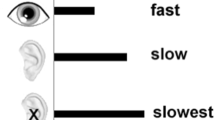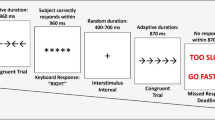Abstract
This study used the modality shift experiment, a relatively simple reaction time measure to visual and auditory stimuli, to examine attentional shifting within and across modalities in 33 children and 42 adults with high-functioning autism as compared to matched numbers of age- and ability-matched typical controls. An exaggerated “modality shift effect” relative to the TD children occurred for the children with autism in conditions involving the reaction time when shifting from sound to light but not from light to sound. No exaggerated MSE was found for the adults with autism; rather, their responses were characterized by a generalized slowness relative to the adults with TD. These results suggest a lag in maturational development in autism in basic information processing mechanisms.
Similar content being viewed by others
References
Allen, G., & Courchesne, E. (2001). Attention function and dysfunction in autism. Frontiers in Bioscience, 6, d105–119.
Bauman, M. L. (1992). Motor dysfunction in autism. In A. B. Joseph & R. R. Young (Eds.), Movement disorders in neurology and neuropsychiatry (pp. 659–661). Boston: Blackwell Scientific.
Behrmann, M., Thomas, C., & Humphreys, K. (2006). Seeing it differently: Visual processing in autism. Trends in Cognitive Sciences, 10, 258–264.
Bogte, H., Flamma, B., van der Meere, J., & van Engeland, H. (2008). Cognitive flexibility in adults with high functioning autism. Journal of Clinical and Experimental Neuropsychology, 30, 33–41.
Boucher, J., & Bowler, D. M. (2009). Memory in autism. Cambridge, UK: Cambridge University Press.
Bryson, S. E., Zwaigenbaum, L., Brian, J., Roberts, W., Szatmari, P., et al. (2007). A prospective case series of high-risk infants who developed autism. Journal of Autism and Developmental Disorders, 37, 12–24.
Cohen, R., & Rist, F. (1992). The modality shift effect. Further explorations at the crossroads. Annals of the New York Academy of Sciences, 658, 163–181.
Courchesne, E., Townsend, J., Akshoomoff, N. A., Saitoh, O., Yeung-Courchesne, R., Lincoln, A. J., et al. (1994). Impairment in shifting attention in autistic and cerebellar patients. Behavioral Neuroscience, 108, 848–865.
Frith, U. (1989). Autism: Explaining the enigma. Oxford: Blackwell.
Frith, U., & Happé, F. (1994). Autism: beyond ‘‘theory of mind’’. Cognition, 50, 115–132.
Frith, U., & Hill, E. (2003). Autism: Mind and brain. New York: Oxford University Press.
Gillberg, C., & Coleman, M. (1992). The biology of the autistic syndromes (2nd ed.). London: MacKeith Press.
Gomot, M., Bernard, F. A., Davis, M. H., Belmonte, M. K., Ashwin, C., Bullmore, E. T., et al. (2006). Change detection in children with autism: An auditory event-related fMRI study. NeuroImage, 29, 474–484.
Happé, F. (1999). Autism: Cognitive deficit or cognitive style? Trends in Cognitive Sciences, 3, 216–222.
Happé, F., & Frith, U. (2006). The weak coherence account: Detailed-focused cognitive style in autism spectrum disorders. Journal of Autism and Developmental Disorders, 36, 5–25.
Hillock, A. R., Powers, A. R., & Wallace, M. T. (2011). Binding of sights and sounds: Age-related changes in multisensory temporal processing. Neuropsychologia, 49, 461–467.
Hughes, C. (1996). Brief report: Planning problems in autism at the level of motor control. Journal of Autism and Developmental Disorders, 26, 99–107.
Ibanez, L. V., Messinger, D. S., Newell, L., Lambert, B., & Sheskin, M. (2008). Visual disengagement in the infant siblings of children with an autism spectrum disorder (ASD). Autism, 12, 473–486.
Just, M. A., Cherkassky, V. L., Keller, T. A., & Minshew, N. J. (2004). Cortical activation and synchronization during sentence comprehension in high-functioning autism: Evidence of underconnectivity. Brain, 127, 1811–1821.
Landry, R., & Bryson, S. E. (2004). Impaired disengagement of attention in young children with autism. Journal of Child Psychology and Psychiatry, 45, 1115–1122.
LeCouteur, A., Rutter, M., Lord, C., Rios, P., Robertson, S., Holdgrafer, M., et al. (1989). Autism diagnostic interview: A standardized investigator-based instrument. Journal of Autism and Developmental Disorders, 19, 363–387.
Leekam, S. R., Hunnisett, E., & Moore, C. (1998). Targets and cues: Gaze-following in children with autism. The Journal of Child Psychology and Psychiatry, 39, 951–962.
Lewkowicz, D. J., & Lickliter, R. (Eds.). (1994). The development of intersensory perception: Comparative perspectives. Hillside, NJ: Lawrence Erlbaum Associates, Inc.
Lord, C., Risi, S., Lambrecht, L., Cook, E. H, Jr, Leventhal, B. L., DiLavore, P. C., et al. (2000). The Autism Diagnostic Observation Schedule-Generic: A standard measure of social and communication deficits associated with the spectrum of autism. Journal of Autism and Developmental Disorders, 30, 205–223.
Lord, C., Rutter, M., Goode, S., Heemsbergen, J., Jordan, H., Mawhood, L., et al. (1989). Autism Diagnostic Observation Schedule: A standardized observation of communicative and social behavior. Journal of Autism and Developmental Disorders, 19, 185–212.
Lord, C., Rutter, M., & LeCouteur, A. L. (1994). Autism diagnostic interview revised a revised version of a diagnostic interview for caregivers of individuals with possible pervasive developmental disorders. Journal of Autism and Developmental Disorders, 24, 659–685.
Mannuzza, S., Kietzman, M. L., Berenhaus, I. J., Ramsey, P. H., Zubin, J., & Sutton, S. (1984). The modality shift effect in schizophrenia: Fact or artifact. Biological Psychiatry, 19, 1317–1331.
Minshew, N. J., & Goldstein, G. (1992). Autism: A distributed neural network deficit? Journal of Clinical and Experimental Neuropsychology, 15, 56.
Minshew, N. J., Goldstein, G., & Siegel, D. J. (1997). Neuropsychologic functioning in autism: profile of a complex information processing disorder. Journal of the International Neuropsychological Society, 3, 303–316.
Minshew, N. J., Luna, B., & Sweeney, J. A. (1999). Oculomotor evidence for neocortical systems but not cerebelllar dysfunction in autism. Neurology, 23, 917–922.
Mottron, L., & Burack, J. (2001). Enhanced perceptual functioning in the development of autism. In J. Burack, T., Charman, N., Yirmiya, & P. R. Zelazo (Eds.), The development of autism (pp. 131–148). Mahway, NJ: Lawrence Erlbaum.
Mottron, L., Dawson, M., Soulières, I., Hubert, B., & Burack, J. (2006). Enhanced perceptual functioning in autism: An update, and eight principles of autistic perception. Journal of Autism and Developmental Disorders, 36, 27–43.
Nadig, A. S., Ozonoff, S., Young, G. S., Rozga, A., Sigman, M., et al. (2007). A prospective study of response-to-name in infants at risk of autism. Archives of Pediatrics and Adolescent Medicine, 161, 378–383.
Oliveras-Rentas, R. E., Kenworthy, L., Roberson, R. B., Martin, A., & Wallace, G. L. (2011). WISC-IV profile in high-functioning autism spectrum disorders: Impaired processing speed is associated with increased autism communication symptoms and decreased adaptive communication abilities. Journal of Autism and Developmental Disorders. Advance online publication,. doi:10.1007/s10803-011-1289-7.
Pascualvaca, D. M., Fantie, B. D., Papageorgiou, M., & Mirsky, A. F. (1998). Attentional capacities in children with autism: Is there a general deficit in shifting focus. Journal of Autism and Developmental Disabilities, 28, 467–478.
Patten, E., & Watson, L. R. (2011). Interventions targeting attention in young children with autism. American Journal of Speech-Language Pathology, 20, 60–69.
Poljac, E., Simon, S., Ringlever, L., Kalcik, D., Groen, W. B., Buitelaar, J. K., et al. (2010). Impaired task switching performance in children with dyslexia but not in children with autism. Quarterly Journal of Experimental Psychology, 63, 401–416.
Reed, P., & McCarthy, J. (2012). Cross-modal attention-switching is impaired in autism spectrum disorders. Journal of Autism and Developmental Disorders, 42, 947–953.
Reitan, R. M., & Wolfson, D. (1993). Halstead-Reitan neuropsychological test battery: Theory and clinical interpretation. Tucson, AZ: Neuropsychology Press.
Rist, F., & Cohen, R. (1991). Sequential effects in the reaction times of schizophrenics: crossover and modality shift effects. In S. R. Steinhauer, J. H. Gruzelier, & J. Zubin (Eds.), Handbook of Schizophrenia (Vol. 5, pp. 241–271). Amsterdam: Elsevier.
Smith, I. M., & Bryson, S. E. (1994). Imitation and action in autism: A critical review. Psychological Bulletin, 116, 259–273.
Sternberg, S. (1969). Discovery of processing stages: Extensions of Donder’s method. Acta Psychologica, 8, 276–315.
Stoet, G., & López, B. (2011). Task switching abilities in children with autism spectrum disorder. European Journal of Developmental Psychology, 8, 244–260.
Sutton, S., Hakerem, G., Zubin, J., & Portnoy, M. (1961). The effect of shift of sensory modality on serial reaction time: A comparison of schizophrenics and normals. American Journal of Psychology, 74, 224–232.
Travers, B. G., Klinger, M. R., & Klinger, L. G. (2011). Attention and working memory in ASD. In D. A. Fein (Ed.), The neuropsychology of autism (pp. 161–184). NY: Oxford University Press.
Wainwright-Sharp, J. W., & Bryson, S. E. (1993). Visual orienting deficits in high functioning people with autism. Journal of Autism and Developmental Disorders, 23, 1–13.
Wechsler, D. (1991). Wechsler intelligence scale for children (3rd ed.). San Antonio, TX: Psychological Corporation.
Wechsler, D. (1997). Wechsler adult intelligence scale (3rd ed.). San Antonio, TX: Psychological Corporation.
Wechsler, D. (2003). Wechsler intelligence scale for children-fourth edition (WISC-IV). San Antonio, TX: Psychological Corporation.
Williams, D. L., Goldstein, G., & Minshew, N. J. (2006). Neuropsychologic functioning in children with autism: Further evidence of disordered complex information processing. Child Neuropsychology, 12, 279–298.
Zubin, J. (1975). Problem of attention in schizophrenia. In M. Kietzman, S. Sutton, & J. Zubin (Eds.), Experimental approaches to psychopathology (pp. 139–166). New York: Academic Press.
Zwaigenbaum, L., Bryson, S., Rogers, T., Roberts, W., Brian, J., & Szatmari, P. (2005). Behavioral manifestations of autism in the first year of life. International Journal of Developmental Neuroscience, 23, 143–152.
Acknowledgments
This work was supported by the National Institute of Neurological Disorders and Stroke (NINDS) [grant number NS33355]; the National Institute of Child Health and Human Development (NICHD) [HD35469, a Collaborative Program of Excellence in Autism (CPEA), to N.J.M.]; the National Institute of Child Health and Human Development [HD055748, an Autism Center of Excellence, to N.J.M.]; and, the National Institute on Deafness and other Communication Disorders (NIDCD) [K23DC006691 to D.L.W.]. The Medical Research Service, Department of Veterans Affairs is also acknowledged for support of this research. The authors are grateful to the participants and their families who generously gave of their time for this research.
Author information
Authors and Affiliations
Corresponding author
Rights and permissions
About this article
Cite this article
Williams, D.L., Goldstein, G. & Minshew, N.J. The Modality Shift Experiment in Adults and Children with High Functioning Autism. J Autism Dev Disord 43, 794–806 (2013). https://doi.org/10.1007/s10803-012-1618-5
Published:
Issue Date:
DOI: https://doi.org/10.1007/s10803-012-1618-5




